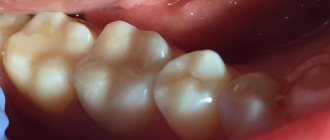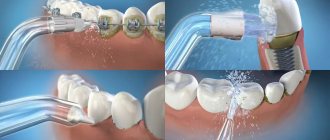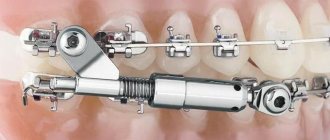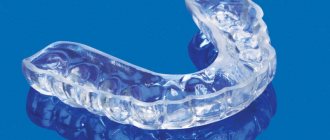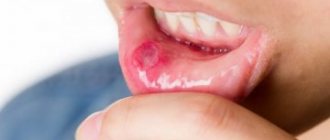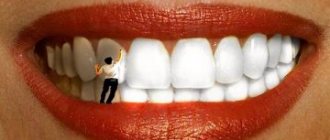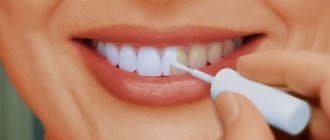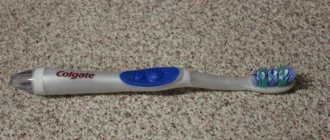3879
In dentistry, there are several types of filling materials, differing in composition, characteristics and release form.
Due to its unique properties, glass ionomer cement is most popular among specialists.
general information
GIC (abbreviated name for glass ionomer cement) is a type of dental material with a heterogeneous (inhomogeneous) structure.
The material was created by Kent and Wilson in 1969 by combining the properties and characteristics of polyacrylic and silicate substances.
Combining the properties of these groups, it has found its use as an insulating liner, raw material for aesthetic restoration, sealing fissures, creating gaskets, filling baby teeth and root canals.
Restoring the integrity of teeth with glass ionomers is gradually replacing cements based on zinc-polycarboxylate and zinc-phosphate.
Compound
The constituent components of cement are chemical compounds that determine its basic properties, namely:
- Crushed quartz 40% (silicon dioxide) – adds transparency, slightly lengthens the working time and the hardening period, slows down the hardening process, and slightly reduces the strength of the hardened mass.
- Aluminum phosphate - while worsening transparency, improves mechanical stability, strength, and structural stability.
- Aluminum oxide – increases strength and acid resistance, but reduces the hardening period and working time.
- Barium salts – added for radiopacity.
- Calcium fluoride - introduced to prevent the recurrence of caries.
This extensive combination of components allows glass ionomer cement to be used in many types of dental work.
Characteristics of Spectrum fillings and expert reviews about the material.
Come here to learn more about the types of cement fillings for teeth.
At this address https://www.vash-dentist.ru/lechenie/zubyi/kofferdam-v-stomatologii.html we will talk about the use and types of rubber dam in dentistry.
Classification
GIC is classified according to several criteria:
- According to the release form.
- According to the chemical composition.
- By area of application.
According to the form of release, the material is classified into the following types:
- Powder-liquid . The composition is traditional - the powder part is represented by finely dispersed aluminofluorosilicate cement with various additives, and the liquid is a water-based carbon copolymer containing tartaric acid.
- Pasty mass in tubes . During operation, mixing is avoided; it hardens when illuminated with a halogen lamp.
- Aquacement . The main component is present in the powder. The powder part is mixed only with distilled water.
- Capsules. In them, the liquid and powder part are packaged in the required ratio. Each capsule contains the required volume of material for one-time use, which eliminates errors and inaccuracy of dosage when preparing the mixture.
According to the chemical composition, GIC is divided into two groups:
- Classic .
This includes powder cement and aqua cement, the main components of which are phosphate and aluminum oxide, strontium, silicon dioxide, fluorides, zinc, and barium salts. In the case of aqua powder, crystals of one of the polycarboxylic acids are added to the composition. The liquid is distilled water or an aqueous solution of polycarboxylic acid. - Hybrid. This is a modified polymer variety. The composition of the powder part is similar to the classical group.
The liquid part is represented by a solution of acids of the polycarboxylic group, the molecules of which are modified by the addition of a methacrylate unsaturated group.Hydroxyethyl methacrylate, camphoroquinone, and tartaric acid were also added. Hardening takes place in 2-3 stages.
The last category includes two subtypes of cement:
- Aesthetic .
The composition has increased the content of silicon oxide, which improves aesthetic characteristics. Strength is reduced, the hardening period is increased and susceptibility to moisture is increased. It is used for the restoration of cervical defects located in the frontal part of incisors and canines, as well as for their caries, closing cavities of 1-2 cells. - Hardened. There are metal additives and special fiber structures.
It is slightly inferior in aesthetic indicators to type 1, but has increased strength, resistance to moisture and accelerated hardening. Etching with acids is acceptable, but only if the thickness of the cement layer is at least 0.1 cm. It is used for caries of milk teeth (if the cavities are 1-2 cells) and molars, for temporary fillings (if they are worn for a long time) and sealing fissures, ART- methodology.
The above classification is temporary and conditional, since new GICs are constantly appearing with a modified composition that improves characteristics, properties and expands the scope of use.
Chemically cured aqua cements.
Presented in the form of a powder that contains fluoroaluminosilicate glass with the addition of polyacid dried at a low temperature and turned into powder. Mix with distilled water. The use of these cements allows us to ensure an optimal glass-acid ratio. These materials have the same disadvantages as “classical” GICs.
One-component light-curing GICs have a polymer matrix that hardens under the influence of light and a glass ionomer filler, but during curing only the photopolymerization reaction of the polymer occurs; no glass ionomer reaction occurs in them.
A new direction was the inclusion of light-curing polymer resin in the GIC composition (hybrid GIC, rubber polymers, GIC modified by polymers). The materials are presented in the form of powder and liquid.
They have two curing mechanisms:
1. Under the influence of light from a photopolymerizer, a “fast” polymerization reaction of the polymer matrix occurs, which creates a dense frame at the initial stage of hardening.
2. Immediately after mixing the powder and liquid, the typical GIC reaction begins, lasting up to 24 hours.
Purpose
The scope of application of glass ionomer cements is extensive. Based on this, it is conditionally divided into 3 types:
- Lutingovy (fixing). Suitable for fastening onlays, inlays, bridge-type prostheses, crowns, orthodontic structures.
The main requirement for fixing GIC is the ability to form a thin (no more than 11-13 microns) film between the crown and the tooth surface.Signs of this type are reduced particle size, long working time, liquid-powder ratio 1:1.5.
- Restoration. Designed to restore various defects of the dental surface. It has increased strength, resistance to dissolution due to changes in its composition, and a changed liquid-powder ratio of 1:3. Approximate curing time 5 minutes.
- Interlining .
Placed under composite or amalgam. Characteristics: short operating time, radiopaque, fast hardening period, powder-liquid proportion based on the required strength, ranges from 1.5:1 to 4:1. Curing period: 5 minutes, no etching. When such manipulation is allowed by the manufacturer, the thickness of the cement layer should not exceed 1 mm.
Important! Glass ionomers cannot be used for oral breathing or to restore a volumetric cavity. This will lead to drying out of the cement (in the first case) or to the development of inflammation in the pulp (in the other case).
Storage
Ionosil should be stored tightly closed at a temperature of 4°C - 23°C, protected from light. Do not use after expiration date.
The Nika Dent online store offers products from the Voco company, which has been operating since 1981. Initially founded as a family business, developing research activities, Voco was able to become one of the leaders in the supply of dental consumables. In the assortment you can find preparations for preventive, restorative and orthopedic dentistry: synthetic materials for filling and glass ionomer cements, materials for restoring tooth stumps, materials for the manufacture of provisional crowns and bridges, adhesives, fluoride-containing varnishes for the prevention of caries and desensitization of teeth. To see all offers, go to the product catalog. Here you can find the full range of Voco products.
Shipping and payment
PAYMENT METHODS
| Cash to the courier upon receipt of the goods. Possible: in Moscow, Moscow region, St. Petersburg, Leningrad region. |
| By bank transfer for legal entities by account. |
TRANSFERING THE ORDER TO THE DELIVERY SERVICE
For cash payments:
the next day after receiving the order, unless a different delivery date has been agreed upon.
For non-cash payments:
the next day after receiving the money to the bank account.
Please check with your manager about the possibility of same-day delivery.
DELIVERY METHODS
Delivery by our transport is carried out in Moscow, Moscow region, St. Petersburg and Leningrad region.
To all other regions, delivery is carried out by transport companies.
Pickup of goods from the warehouse and company office is not provided.
COST OF DELIVERY
| Within the Moscow Ring Road: when ordering over 3,000 rubles - free. Up to 3,000 rubles – we temporarily do not deliver. |
| IN ST. PETERSBURG : when ordering over 3,000 rubles - free. Up to 3,000 rubles – delivery cost 350 rubles. |
| IN THE MOSCOW REGION: up to 50 km from the Moscow Ring Road: for orders over 5,000 rubles - free. Up to 5000 rubles – we temporarily do not deliver. 50-100 km from the Moscow Ring Road: for orders over 30,000 rubles - free. Up to 30,000 rubles – we temporarily do not deliver. |
| IN THE LENINGRAD REGION: up to 20 km from the Ring Road: for orders over 5,000 rubles - free. In all other cases - individually |
| TO OTHER REGIONS The minimum order amount to the regions is 3,000 rubles. Delivery is carried out by a transport company. The cost of delivery to the Moscow base of the transport company is free. Payment for the services of the transport company is at the expense of the client. We work with any Transport companies convenient for you! |
Repeated delivery due to the buyer's fault will be paid in any case!
Reviews
There are no reviews for this product yet. Be the first to leave a review!
Advantages
The main advantage of the material is its high degree of adhesion to dental tissues. This property is achieved by combining calcium found in the tooth surface with the carboxyl group of polymer molecules.
Also, at the final stage of hardening, an increase in the volume of cement is observed, which ensures its good marginal fit.
Other advantages of the GIC include the following characteristics:
- Chemical compatibility and good adhesion to composites , metals, and materials containing eugenol.
- The presence of bacteriostatic and cariesostatic effect. Their manifestation is based on the release of fluorides during and upon completion of glass ionomer hardening, as well as the formation of a fluorapatite layer (the effect lasts up to a year).
- The presence of a “battery” effect , i.e. ability to adsorb fluoride ions from pastes and remove them into surrounding tissues.
- Biological compatibility , the material is non-toxic, which makes it possible to use it for insulating gaskets.
- The thermal expansion index is close to that of dentin tissues and enamel. This property prevents cracking of the cement and disruption of its adherence when the temperature in the mouth fluctuates.
- Low coefficient of elasticity - allows filling large (5 cells) cavities.
- Sufficient compressive strength , which makes it possible to use GIC as a base for a composite when performing “sandwich” fillings.
- The minimum shrinkage during polymerization is no more than 3.5%. This figure is 45% less than that of photocomposites.
- Convenient and easy to work with. The use of most of them does not involve preliminary etching or bonding (application of polymer) of the enamel.
- It hardens in humidity , which makes it possible to fill a wedge-shaped defect or cervical cavities.
- Low cost.
Let’s calculate together how much it costs to put a filling on a front tooth, and discuss the factors that influence the price.
In this publication we will tell you what to do if a filling unexpectedly falls out.
Here https://www.vash-dentist.ru/lechenie/zubyi/plombyi/svetovyie-na-perednih-osobennosti-plyusyi-i-minusyi-stoimost.html we will find out how much a light filling for a front tooth costs.
Ormokers
Ormokers are ORGANIC MODIFIED CERAMICS. This type of material consists of particles - barium glass, fluorapatite, which form an organic matrix. The size of particles in ormokers reaches up to 1.7 microns. Ormokers are well filled up to 70% by volume. Ormokers have good strength; some literature sources even recommend the use of ormokers in patients with allergies to composites, but there are no confirmed clinical cases. The positive properties of ormokers, which leads to their use in restoration of any class according to Black, include:
- Good strength;
- Minimal shrinkage;
- Wear resistance;
- Aesthetics;
- Polishability.
However, in terms of their application, ormokers are inferior to microhybrid composites.
Silorans
Siloranes are representatives of a new era of substances in dentistry. Siloranes also contain substances used in the chemical industry. However, this material is distinguished by its good biocompatibility, low shrinkage, and wear resistance. Silorans have a convenient working time, which reaches up to 9 minutes in the presence of general lighting.
Siloranes are used to restore Black class 1–2. There are some nuances in working with silorans. The first is the need to install a gasket; the second is its incompatibility with adhesive systems of compomers and flowable composites. However, silorans are pleasant to work with: they do not stick to the tool, pack well and are polished.
At this point in time, unfortunately, there are no long-term clinical results with the use of silorans, but the prospects for this group of materials are not bad!
Compomers
Compomers are a duo of composite and glass ionomer cement. This group of materials combines the properties of both composite and GIC. The curing mechanism of compomers is described as a cascade, where first polymerization occurs under the influence of light, and then under the influence of water an acid-base reaction characteristic of cement is activated.
Compomers have the following properties:
- Elastic filling material;
- Fluoride release;
- Undemanding to working conditions: can be applied in large portions, does not require careful isolation from water, you can skip the pickling stage;
- Reacts less to specifically targeted rays of the polymerization lamp.
With such properties, the compomer is used to restore Black classes 3 and 5, restorations on baby teeth, and fissure sealing.
Flaws
Glass ionomers have the following disadvantages:
- Long "maturation" . Primary hardening takes 5-7 minutes, final hardening takes up to 24 hours.
- The first 24 hours after filling are sensitive to a deficiency or excess of moisture , which is why in the first case the structure is disrupted, and in the second case ions are washed out. To prevent these phenomena, the filling is coated with protective dental varnish.
- There is sensitivity to mechanical stress , so grinding and polishing of the filling is carried out at the second visit.
- GIC cannot be etched with orthophosphoric acid , since this procedure disrupts the ripening process.
- Insufficient diametric tensile strength , which does not allow the material to be used in areas experiencing increased multidirectional loads.
- Low abrasion resistance , making it impossible to seal cavities that experience high loads.
- In terms of aesthetic indicators, it is slightly inferior to the composite. Problems include high transparency and difficulty in polishing.
- Cannot be used for sealing deep cavities , because... GIC adsorbs fluids from pulpal odontoblasts.
Currently, the process of improving glass ionomers and eliminating their shortcomings continues.
The hardening reaction of GIC occurs in three stages:
1. stage of ion formation (dissolution stage) - the acid reacts with the surface layer of glass particles to form calcium, aluminum, photor and sodium cations;
2. phase of primary gelation (hardening) - rapid cross-linking of polyacid molecules with each other, calcium and aluminum ions. At this stage, the pH of the cement begins to increase noticeably. The transformation of polyacid molecules into a gel begins;
3. stage of final hardening - strong transverse ionic bonds are formed, mainly of aluminum polyalkenate and fluorine (lasts up to 24 hours).
The trivalent nature of aluminum allows for a higher degree of cross-linking, which determines the final strength of the material. At this stage, the process of formation of silica gel on the surface of glass particles is completed.
The final structure of hardened cement is: glass particles, each of which is surrounded by silica gel, located in a matrix consisting of cross-linked polyacid molecules containing insoluble fluorine and phosphate salts.
Mode of application
The principle of working with cement depends on its type and method of hardening. So, the use of this material with a classic composition or aqua cement takes place in the following sequence:
- The oral cavity is treated with conditioner.
- In 20 minutes. the mouth is rinsed and dried.
- The problem unit is isolated from moisture.
- Mix the liquid with the powder until a homogeneous mass is obtained (about 30-40 seconds).
- The prepared mass is placed into the tooth cavity.
- The filling is modeled and condensed with a plugger or a moistened cotton swab.
- When finished, it is coated with a protective varnish.
Its grinding and polishing is carried out only on the next visit.
Filling technology using double-curing GIC:
- The enamel is etched with phosphoric acid and dried.
- The tooth is isolated from moisture.
- The adhesive mass is applied and polymerized.
- In accordance with the required proportion, 2 pastes are mixed.
- The cavity is dried and separated from moisture.
- Cement is added in layers until the required filling height is obtained. Each layer is condensed and illuminated by a photopolymerizer.
- The finished filling is processed with burs.
If triple-cured material is used, filling takes place in the following sequence:
- Dental tissues are etched with phosphoric acid, which is then washed off and the cavity is dried.
- The working area is separated from saliva.
- The adhesive mixture is applied.
- The cavity is purged and illuminated.
- Cement is mixed.
- The finished mass is placed in one portion and condensed.
- The filling is ground and then polished.
Important! The dentist warns the patient that for the first 2-3 weeks the color of the filling will be lighter than the natural dental tissues.
When working with glass ionomers, it is important for a specialist to remember several important points:
- When used as a gasket under the amalgam mass, the thickness of the applied layer should be at least 0.1 cm.
- When working with “classics”, it is important to achieve the optimal percentage of fabric moisture.
- An acceptable period for cementing orthopedic products and pins is considered to be when the cement is in the “stretching thread” phase, i.e., when tearing off a spatula produces a stretching thread.
- The hybrid variety requires tissue etching and the use of an adhesive system.
The video presents a technique for using glass ionomer cement for filling.
Manufacturers' offers
Dentists use several types of glass ionomer cements. The most popular brands are the following.
Vitremer
The only type of glass ionomer with triple curing. It has good adhesion to dental tissues even at high relative humidity and without etching.
This argument allows it to be used for restoration, restoration of mammary elements, as well as for securing orthopedic structures.
The advantages include the following indicators:
- does not involve layer-by-layer application and preliminary creation of a gasket;
- the degree of solubility is low;
- high coefficients of elasticity and strength;
- prolonged release of fluorides;
- improved aesthetic characteristics;
- easy to use;
- radiopaque.
Fuji IILC
It hardens in the light, is radiopaque, has biocompatibility, stable chemical adhesion, decent appearance and is capable of releasing fluoride.
Applicable:
- filling cavities of classes 3 and 4;
- restoration of milk units;
- fixing the pins.
After application it is sensitive to humidity, so it is recommended to apply a protective varnish over the filling.
Shelon-Phil
This is a polymaleic GIC filling that is bonded to dental tissues by a chemical reaction. Creates a tight seal, is used without a gasket if the cavity is not deep (dentine thickness is less than 1.5 mm - the presence of a gasket is required), releases fluoride ions, nourishing the tissues adjacent to it.
It is used for filling frontal units, cavities from classes 1 to 4, milk elements, wedge-shaped defects, shallow fissures and in modeling a dihedral base.
The filling requires mandatory varnishing, and subsequent processing (grinding and polishing) is carried out after 7-10 minutes. after varnishing.
Ketak-Molar
The material is radiopaque, chemically cured. Used to treat permanent chewing and milk units.
It is characterized by resistance to removal, releases fluorides, and condenses. Working time – 3 minutes, hardening period – no more than 5 minutes.
Available in two versions:
- Applicap. Radiopaque, dosed in capsules, used for filling mammary and permanent elements. Resistant to compression and abrasion, operating time - 2 minutes, hardening time taking into account mixing time - 4 minutes.
- Plus. Chemically hardened cement, radiopaque, suitable for the treatment of permanent frontal and mammary units. Capable of releasing fluorides in the fabric, ensures a secure fit, and is color fast. Working time – 2 minutes, curing time – 7 minutes.
Positive properties of dual-curing hybrid GIC:
1. less sensitive to moisture and dehydration;
2. have improved strength characteristics compared to “traditional” ones;
3. harden without the formation of microcracks;
4. have increased adhesion force to tooth tissues.
Negative properties of dual-curing hybrid GIC:
1. the polymer matrix hardens only under the influence of light from a photopolymerizer;
2. strength characteristics and color range are worse than those of FKM. Triple-cure hybrid GIC
Work to improve glass ionomers led to the creation of the hybrid cement “Vitrimer” (ZM E5PE). This is the only glass ionomer cement that uses triple curing technology:
1) light curing of the polymer matrix occurs directly during light irradiation. This makes it possible to achieve high strength already in the process of applying the filling, ensures ease of use, and reduces the possibility of contamination;
2) chemical curing of the polymer matrix is ensured by the powder containing microcapsules with a proprietary catalytic system. When the powder is mixed with liquid, the capsules are destroyed and the catalyst is activated. The presence of a mechanism for chemical curing of the polymer matrix of the material ensures guaranteed complete curing of all areas of the filling, even without light irradiation. Thus, there is no need for layer-by-layer application of material. Applying a filling, even a large one, using only one portion of material allows you to obtain a uniform structure and significantly saves time;
3) the “classical” glass ionomer curing reaction, characteristic of all glass ionomers, lasts for 24 hours and occurs inside a durable polymer “frame”. The glass ionomer reaction provides Vitrimer with chemical adhesion to the hard tissues of the tooth, biocompatibility, prolonged release of fluoride, and, consequently, high quality restoration and a reduced likelihood of developing “recurrent” caries.
Indications for use of the hybrid glass ionomer triple-curing system “Vitrimer” (ZM E5PE):
1. Aesthetic filling of carious cavities of classes III and VI in adults.
2. Filling of non-carious tooth defects: erosion, wedge-shaped defects, etc.
3. Filling cavities of all classes in baby teeth.
4. Dental filling in gerontostomatology.
5. Temporary restoration of broken teeth.
6. Restoration of a destroyed tooth crown with the creation of a stump for the crown (blue tint).
7. Basic gasket when filling a tooth using the “sandwich” method.
8. In case of unsatisfactory oral hygiene, high incidence of “recurrent” caries, filling of tooth root defects.
Price
Filling is an expensive dental service. The final cost is influenced by the location of the element being restored and its condition, the complexity of the procedure, the equipment used, the type of filling, the pricing policy of the center, its status and location, and the qualifications of the specialist.
The volume of therapy performed, the type of anesthetic administered, and the number of preparatory procedures are also important.
The average price for filling one tooth with GIC ranges from 1200 rubles. up to 1600 rub.
Reviews
Dentists use several types of filling materials in their work. But of these, the most popular are cement glass ionomer masses.
This is due to a large number of advantages, the main ones being durability and affordability.
You can tell us about your experience of restoring teeth with fillings based on this material and express your opinion about its quality by leaving your comment on this article.
If you find an error, please select a piece of text and press Ctrl+Enter.
Tags treatment of fillings glass ionomer cement
Did you like the article? stay tuned
Previous article
Gutta-percha points – high-quality root filling
Next article
Difficulties in identifying initial pulpitis and treatment tactics
